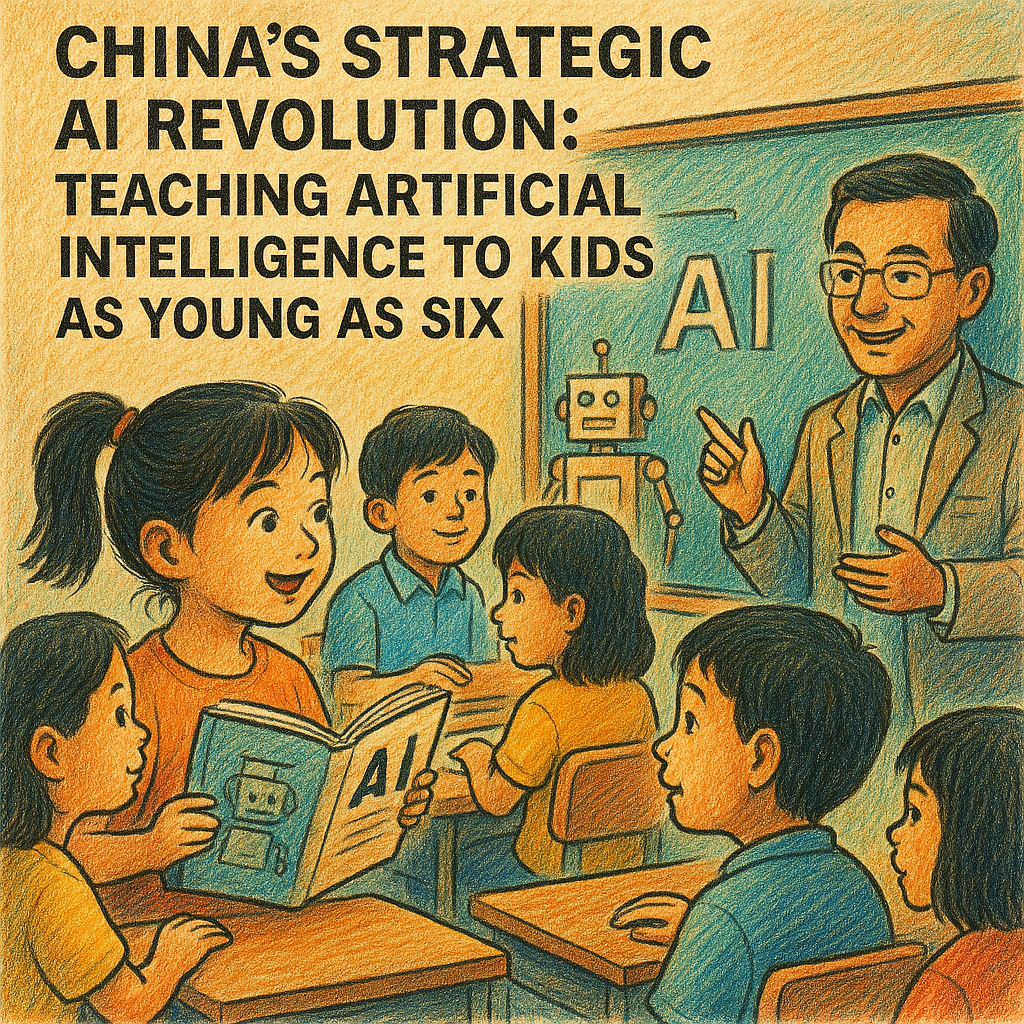
China’s Strategic AI Revolution: Teaching Artificial Intelligence to Kids as Young as Six
China has embarked on one of the most ambitious educational overhauls in modern history — integrating Artificial Intelligence (AI) education into the core curriculum for students as young as six. This is not merely a curriculum tweak; it’s a visionary national strategy with profound implications. It represents a foundational shift in how a country prepares its next generation, not just for jobs, but for leadership in a world where AI is central to economic power, defense, healthcare, and global influence.
A National Blueprint, Not Just an Experiment
The initiative, jointly led by China’s Ministry of Education and the Ministry of Science and Technology, reflects the alignment of state apparatus, industry giants, and academic institutions around a singular goal: to become the world leader in AI.
China has introduced age-appropriate, AI-centric textbooks starting from primary levels, emphasizing concepts like pattern recognition, algorithmic thinking, and simple machine learning models — all presented through storytelling, games, and visual simulations tailored for young minds. As students progress through the system, the curriculum becomes increasingly sophisticated, incorporating hands-on projects using AI kits, robotics platforms, and visual programming tools.
By middle school, students are exposed to real-world applications of AI such as facial recognition, natural language processing, and smart city simulations. High schools offer elective tracks in machine learning, data science, and ethical AI, often mentored by engineers from top firms like Baidu, Alibaba, Huawei, and Tencent. The AI education pipeline culminates in specialized university programs and research fellowships that connect directly with industry needs and national goals.
What’s most striking is the inclusivity of the plan — AI labs and learning tools are being deployed not just in elite urban institutions, but in rural and underdeveloped regions too. This ensures that talent from every corner of the country can participate in the AI revolution.
Strategic Intent: Technology as Infrastructure
China’s approach reveals how it views AI: not as an optional skill or luxury, but as core infrastructure — as vital as roads, electricity, and broadband. In this context, teaching AI from a young age is no different from teaching children how to read and write. It’s about equipping citizens with the cognitive tools necessary to thrive in a digital-first world.
This early literacy offers multiple advantages. First, it ingrains computational thinking and problem-solving abilities at the most formative stages of learning. Second, it provides a head start in global job markets where AI fluency is becoming a basic requirement, not a specialization. Third, it lays the groundwork for domestic innovation, reducing reliance on foreign technologies and fostering sovereign control over critical digital infrastructure.
Ultimately, China is not just creating coders or engineers — it is sculpting the architects of its future digital civilization.
Implications for the World: A Geopolitical Shift in the Making
The ripple effects of this strategy will be global. Over the next two decades, we can anticipate a sharp increase in Chinese-origin AI startups, research breakthroughs, and digital governance models. With a population that speaks the language of AI natively from a young age, China is setting itself up to dominate talent pipelines, influence international standards, and shape the ethical and philosophical boundaries of AI.
Just as the U.S. once reigned supreme by investing in STEM education during the Space Race, China’s AI education campaign is positioning it for a similar kind of soft and hard power dominance — this time, in the digital realm.
A Wake-Up Call for India — and the Rest of the World
India, with its massive youth population and thriving tech ecosystem, is uniquely positioned to respond — but the gap is widening. Today, AI education in India remains largely siloed in higher education and urban elite institutions. Millions of students, especially in Tier II, Tier III cities and rural areas, remain untouched by the AI wave.
If this imbalance persists, India risks a dangerous dependency on foreign AI solutions, potentially relinquishing control over sensitive technologies in agriculture, healthcare, defense, and finance. The consequences would not only be economic — they would be strategic and societal.
What India Must Do: A Blueprint for Response
India’s response must be swift, scalable, and strategic:
- National AI Curriculum Starting in Primary School: Just as mathematics or science is a fundamental subject, AI should be introduced as a core subject from Class 1 onward, using age-appropriate tools, gamified learning, and localized examples.
- Regional Language Accessibility: AI literacy should not be an English-only privilege. Platforms and materials must be translated and adapted into regional languages to ensure inclusivity.
- Massive Teacher Training Programs: Upskilling educators is critical. Specialized training certifications, AI teaching fellowships, and collaborations with Indian edtech companies and academic institutions must be prioritized.
- Government-Supported AI Labs in Public Schools: Partnerships between the government and private sector can create affordable, scalable AI lab models, similar to India’s computer lab push two decades ago.
- National AI Competitions & Talent Spotting: Initiatives like an “AI Olympiad,” hackathons, and innovation challenges can identify young prodigies and foster a culture of AI-based problem-solving and entrepreneurship.
- Ethics + Innovation: India can differentiate itself by leading with “human-centered AI” — integrating philosophy, ethics, and societal impact into technical training from the start.
The New Battleground: Education as a Strategic Asset
The global AI race is not only about who builds the best models or runs the fastest computations. It’s about who educates their people first and best. It’s about who prepares their children not just to use technology, but to create and direct it.
China has made its move. Decisively. Strategically. Systemically.
Now, it’s up to India — and the rest of the world — to choose: will they watch from the sidelines, or rise to meet the moment?






